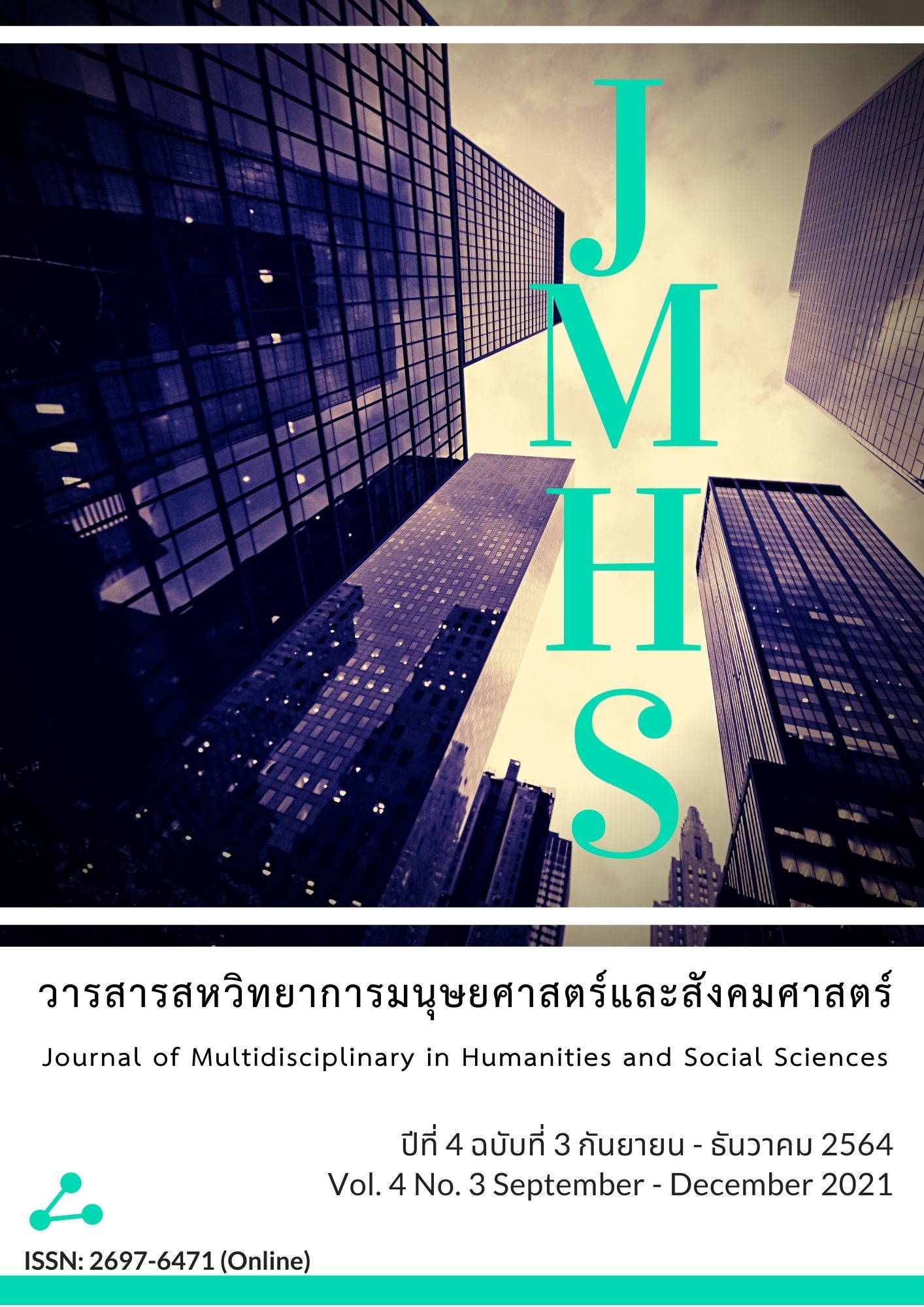The Influence of Causal Factors Positive Electronic Word of Mouth on Facebook Fanpage about Cultural Attractions of Thai Tourists
Main Article Content
Abstract
The purposes of this article aimed (1) to develop and examine the consistency of the causal relationship model in factors of positive electronic word of mouth on Facebook Fanpage about the cultural attractions of Thai Tourists; and (2) to study the causal factors of positive electronic word of mouth on Facebook Fanpage about the cultural attractions of Thai tourists. This study was quantitative research. The instrument for collecting data was an online questionnaire. The sample group was 215 Thai people who had previously traveled to cultural attractions in Thailand. The statistics used in data analysis were frequency, percentage, and structural equation model. The research results were found as follows:
1. The causal influence of the variables consisting of four components was 1) Affective Place Image, 2) Self-Congruity, 3) Place Attachment, and 4) Positive Electronic Word of Mouth and developed models were consistent with the empirical data to a great extent. The statistics showed the Chi-square statistics goodness fit test (2) = 173.29, degrees of freedom (df) = 151, CMIN/df = 1.15, GFI = 0.93, AGFI = 0.90, SRMR = 0.05, RMSEA = 0.04. The final was predictive coefficient of 0.83, indicating that the variables in the model can explain the positive electronic word of mouth by 83 percent.
2. The influence of causal factors positive electronic word of mouth was Affective Place Image, Self-Congruity, and Place Attachment respectively.
Article Details
Views and opinions appearing in the Journal it is the responsibility of the author of the article, and does not constitute the view and responsibility of the editorial team.
References
กริช แรงสูงเนิน. (2554). การวิเคราะห์ปัจจัยด้วย SPSS และ AMOS เพื่อการวิจัย. กรุงเทพฯ: ซีเอ็ดยูเคชั่น.
กุลนิษฐ์ พงศ์พันธุ์พณิชย์ และ สุมามาลย์ ปานคำ. (2563). โมเดลความสัมพันธ์เชิงสาเหตุความตั้งใจใช้บริการเทรนเนอร์ออนไลน์ผ่านโซเชียลมีเดียของผู้บริโภคในเขตกรุงเทพมหานครและปริมณฑล. วารสาร มจร. พุทธปัญญาปริทรรศน์, 5(2), 94-106.
กัณฐิกา จิตติจรุงลาภ. (2562). การสื่อสารแบบปากต่อปากอิเล็กทรอนิกส์ต่อพฤติกรรมการซื้อสินค้าออนไลน์. วารสารระบบสารสนเทศด้านธุรกิจ, 5(2), 43 – 65.
จีราวัฒน์ คงแก้ว. (2556). STARTUP เทรนด์ร้อน..!! ธุรกิจเกิดใหม่. สืบค้นเมื่อ 26 มีนาคม 2564, จาก http://www.bangkokbiznews.com/news/detail/538848.
ชไมพร กาญจนกิจสกุล. (2555). ระเบียบวิธีวิจัยทางสังคมศาสตร์. จ.ตาก: โพรเจ็คท์ ไฟฟ์-ไฟว์.
ชนินันท์ ทิพย์ธัญญา. (2561). ความสอดคล้องในตนเอง คุณภาพสินค้าและบริการ ภาพลักษณ์ตราสินค้า และการออกแบบผลิตภัณฑ์ที่ส่งผลต่อการตัดสินใจเลือกซื้อสินค้าแบรนด์ยูนิโคล่ของผู้บริโภคในกรุงเทพมหานคร(การศึกษาค้นคว้าอิสระบริหารมหาบัณฑิต). มหาวิทยาลัยกรุงเทพ.
ทิพย์สุภา ตั้งวงศ์เจริญลาภ. (2553). สาเหตุและแรงกระตุ้นของพฤติกรรมจงรักภักดีมากกว่า 1 แบรนด์ขึ้นไป(การศึกษาค้นคว้าอิสระวิทยาศาสตรมหาบัณฑิต) มหาวิทยาลัยธรรมศาสตร์.
นงลักษณ์ วิรัชชัย. (2542). โมเดลลิสเรล: สถิติวิเคราะห์สำหรับการวิจัย. (พิมพ์ครั้งที่ 3). กรุงเทพฯ: โรงพิมพ์แห่งจุฬาลงกรณ์มหาวิทยาลัย.
บริษัท ยูเรก้า คอนซัลติ้ง จำกัด. (2555). ภาพลักษณ์ด้านการท่องเที่ยวของประเทศไทยในสายตาของนักท่องเที่ยวชาวต่างชาติ. สืบค้นเมื่อ 6 เมษายน 2564, จาก https://issuu.com/etatjournal/docs/thailand_destination_image
ปิยะพร ธรรมชาติ และ สวัสดิ์ วรรณรัตน์. (2563). อิทธิพลของการบอกต่อผ่านอินเทอร์เน็ต (eWOM) และแรงจูงใจในการท่องเที่ยวต่อทัศนคติการเดินทางของนักท่องเที่ยวสูงอายุคนไทย. วารสารสมาคมนักวิจัย, 25(1), 128-153.
พัชราภรณ์ มหาสุวีระชัย. (2561). ภาพลักษณ์เมืองและความพึงพอใจของประชาชนท้องถิ่น: กรณีเมืองขอนแก่น. WMS Journal of Management, 7(3), 65-75.
รัตนาภรณ์ ศรีม่วง. (2559). การศึกษาระดับความพึงพอใจของนักท่องเที่ยวที่มีต่อสถานที่ท่องเที่ยวหุ่นเหล็กโคราช ตำบลมะเกลือใหม่ อำเภอสูงเนิน จังหวัดนครราชสีมา. นครราชสีมา: มหาวิทยาลัยราชภัฏนครราชสีมา.
รัศมิ์ลภัส วรเดชธนันกุล. (2558). ความไว้วางใจ การสื่อสารแบบปากต่อปากเชิงบวก และการรับรู้ถึงประโยชน์ที่มีผลต่อความตั้งใจซื้อแพ็กเกจทัวร์ผ่านเว็บไซต์ท่องเที่ยวของผู้บริโภคในจังหวัดระยอง(การศึกษาค้นคว้าอิสระบริหารมหาบัณฑิต). มหาวิทยาลัยกรุงเทพ.
ลัดดาวัลย์ เดือนฉาย. (2556). ปัจจัยที่มีอิทธิพลต่อความรู้สึกผูกพันกับพื้นที่และพฤติกรรมการอนุรักษ์ของผู้มาเยือนอุทยานแห่งชาติแก่งกระจาน(วิทยานิพนธ์วิทยาศาสตรมหาบัณฑิต). มหาวิทยาลัยเกษตรศาสตร์.
อดิศร ศรีเสาวนันท์ และ วีระ อินพันทัง. (2559). แนวความคิดเรื่องสถานที่ และปรากฏการณ์วิทยากับการศึกษางานสถาปัตยกรรมพื้นถิ่น. วารสารวิชาการคณะสถาปัตยกรรมศาสตร์ มหาวิทยาลัยขอนแก่น, 15(1), 1-20.
Hoelter, J. W. (1983). The Analysis of Covariance Structures: Goodness-of-Fit Indices. Sociological Methods and Research, 11(3), 325–344.
Hootsuite. (2020). Digital 2020 Global Overview Report. Retrieved April 6, 2019, from https://wearesocial.com/blog/2020/01/digital-2020-3-8-billion-people-use-social-media
Industrial New. (2564). อุตสาหกรรมการท่องเที่ยว ธุรกิจทำเงินเข้าประเทศไทย. สืบค้นเมื่อ 5 เมษายน 2564, จาก https://industrialnew.com.
Kline, R. B. (2011). Principles and Practice of Structural Equation Modeling. (3rd ed.). New York: Guilford Press.
Strandberg, C., Styvén, M. E., & Hultman, M. (2020). Places in Good Graces: The Role of Emotional Connections to A Place on Word of Mouth. Journal of Business Research, 119(1), 444-452.


